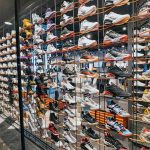Lululemon Athletica has clearly made peace with this recession as third quarter earnings for the Vancouver-based retailer of yoga wear and other athletic apparel catapulted 60.2% to $14.1 million or 20 cents a share. Comps jumped 10% and gross margin levels reached almost 50%. Revenues jumped 28.9% to $112.9 million from $87.0 million in the year-ago period. The latest results bested recently-upgraded guidance for revenue of $110 million to $112 million and earnings of 17 cents to 19 cents per share.
The comp sales gain was its first positive result since the 2008 third quarter. Boosting sales was the addition of eight new corporate-owned stores opened since third quarter last year, a stronger Canadian dollar that increased reported revenues by $800,000; and $4.2 million in e-commerce revenues. E-commerce launched in the second quarter with free shipping introduced in October.
Corporate-owned stores represented 87% of total revenue while franchise and other revenues, which includes wholesale, showrooms, outlets, warehouse sales — and now e-commerce sales, made up the balance, or $14.8 million.
On a conference call with analysts, company CEO Christine Day said the comp sales gain was driven by positive results in both Canada and the U.S., “with the U.S. being very strong, especially in the new stores that opened Q3 of last year…”
Day noted that the gains were achieved without increasing promotional cadence. “Our focus on new colors and styles delivered weekly creates a scarcity model that provides an immediate guest purchase,” she said. “This focus, combined with an upbeat staff and store environment have proven over and over to be a winning formula.”
Regarding categories, Lululemon's yoga line “remains a core revenue driver,” and was helped by the introduction of increased choices of technical fabric in its tank line and “a new hot yoga line.” LULU also continued to see “an incredible reaction” to its running push, with an expanded line of shorts, crops and outerwear. Its running skirt has been particularly successful. Growth in men’s was helped by new product introductions such as a ribbed compression line, more color and technical tops. Its natural fabric line also “continues to perform nicely,” according to Day.
Day said the concept is being helped by its focus on healthy
living, “particularly in the U.S. where the healthcare debate keeps the costs of healthcare top-of-mind for consumers.” But she said that as store managers increase their tenures with the company, the chain becomes more connected to local yoga and fitness enthusiasts. Grassroots efforts such as offering complimentary classes at events are also helping this effort.
Gross margins improved to 49.9% from 48.1% due to a 110 basis point improvement in merchandise margin, which was driven by improved sourcing on fall merchandise, and reduced markdowns. These cost reductions were partially offset by air freight costs incurred to keep pace with stronger than expected sales demand.
Day said the company's bottom line ultimately benefited from steps taken earlier to brace itself for the recession without turning to traditional promotion. These included bringing in “more value” to its products such as technical functionality and new fabrics without increasing prices. Merchandising efforts were also focused on pieces at certain strong selling price points, such as within its running line and reduced prices of some key accessories to drive traffic.
SG&A expenses were reduced to 31.4% of sales from 33.2% as better sales leverage offset increased costs related to store payroll and administrative fees, new stores, e-commerce development and ongoing litigation.
Inventories were up 6% at the quarter's end. March and April inventory is being brought in earlier this year due to Chinese New Year, which falls three weeks later in February. Day said this will also allows Lululemon to meet additional demand in the fourth quarter without running the risk of having excess fall winter goods.
For the fourth quarter, Lululemon is projecting net revenue of $140 million to $145 million based on a same-store sales increase in the mid-teens on a constant-dollar basis. It also projects earnings of 26 cents to 28 cents per share for Q4, which compares with 20 cents a year ago.
Looking to 2010, 15 new stores are being planned with a focus on in-filling existing markets, primarily in the U.S. Three ivivva athletica stores — which target active 6 to 12 year olds — have opened and initial results “tell us we have a winning concept, and we will continue to develop and refine the model over the next few quarters,” said Day.















